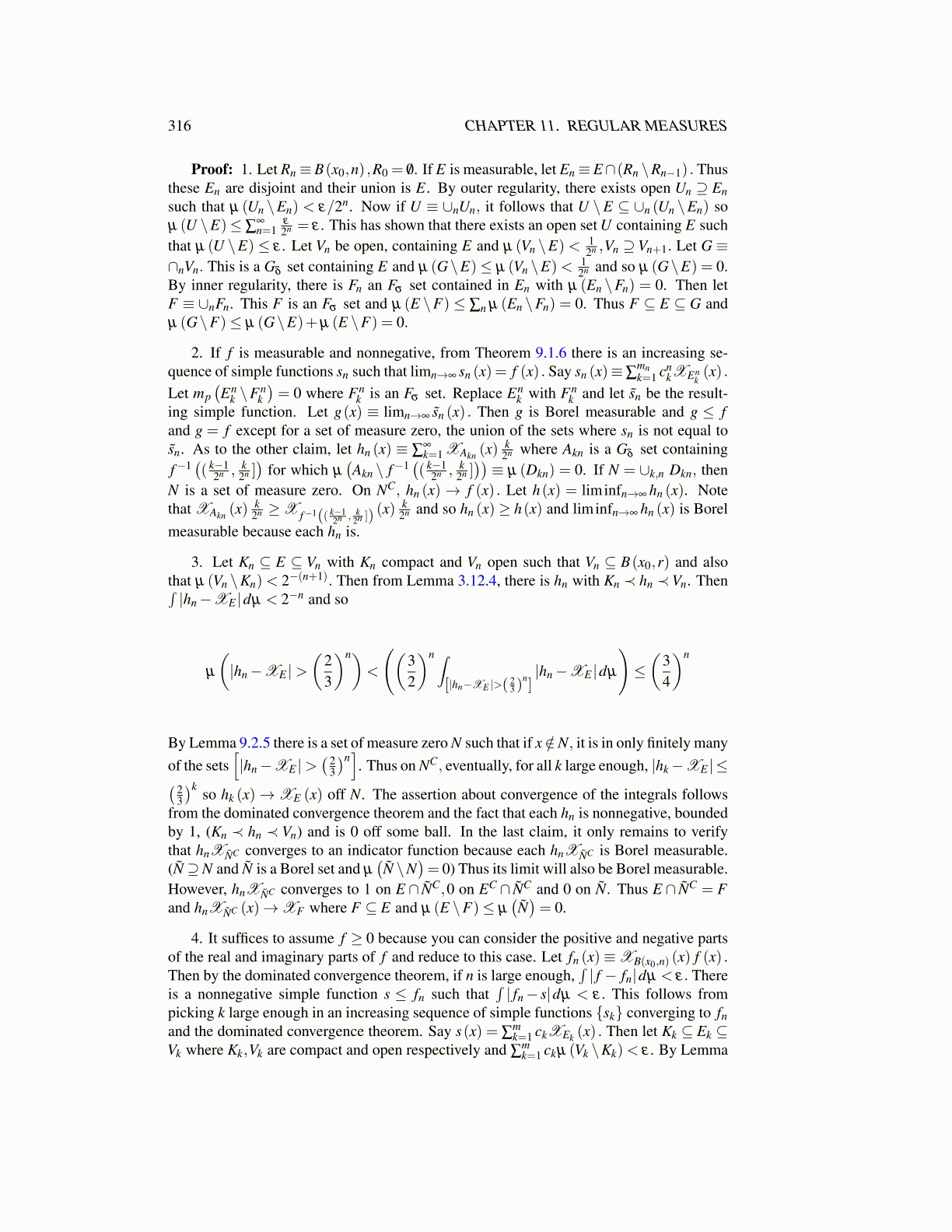
316 CHAPTER 11. REGULAR MEASURES
Proof: 1. Let Rn≡B(x0,n) ,R0 = /0. If E is measurable, let En≡E∩(Rn \Rn−1) . Thusthese En are disjoint and their union is E. By outer regularity, there exists open Un ⊇ Ensuch that µ (Un \En) < ε/2n. Now if U ≡ ∪nUn, it follows that U \E ⊆ ∪n (Un \En) soµ (U \E)≤∑
∞n=1
ε
2n = ε . This has shown that there exists an open set U containing E suchthat µ (U \E) ≤ ε . Let Vn be open, containing E and µ (Vn \E) < 1
2n ,Vn ⊇ Vn+1. Let G ≡∩nVn. This is a Gδ set containing E and µ (G\E)≤ µ (Vn \E)< 1
2n and so µ (G\E) = 0.By inner regularity, there is Fn an Fσ set contained in En with µ (En \Fn) = 0. Then letF ≡ ∪nFn. This F is an Fσ set and µ (E \F) ≤ ∑n µ (En \Fn) = 0. Thus F ⊆ E ⊆ G andµ (G\F)≤ µ (G\E)+µ (E \F) = 0.
2. If f is measurable and nonnegative, from Theorem 9.1.6 there is an increasing se-quence of simple functions sn such that limn→∞ sn (x) = f (x) . Say sn (x)≡∑
mnk=1 cn
kXEnk(x) .
Let mp(En
k \Fnk
)= 0 where Fn
k is an Fσ set. Replace Enk with Fn
k and let s̃n be the result-ing simple function. Let g(x) ≡ limn→∞ s̃n (x) . Then g is Borel measurable and g ≤ fand g = f except for a set of measure zero, the union of the sets where sn is not equal tos̃n. As to the other claim, let hn (x) ≡ ∑
∞k=1 XAkn (x)
k2n where Akn is a Gδ set containing
f−1(( k−1
2n , k2n ])
for which µ(Akn \ f−1
(( k−1
2n , k2n ]))≡ µ (Dkn) = 0. If N = ∪k,n Dkn, then
N is a set of measure zero. On NC, hn (x)→ f (x) . Let h(x) = liminfn→∞ hn (x). Notethat XAkn (x)
k2n ≥X f−1(( k−1
2n , k2n ]) (x)
k2n and so hn (x)≥ h(x) and liminfn→∞ hn (x) is Borel
measurable because each hn is.
3. Let Kn ⊆ E ⊆ Vn with Kn compact and Vn open such that Vn ⊆ B(x0,r) and alsothat µ (Vn \Kn)< 2−(n+1). Then from Lemma 3.12.4, there is hn with Kn ≺ hn ≺Vn. Then∫|hn−XE |dµ < 2−n and so
µ
(|hn−XE |>
(23
)n)<
((32
)n ∫[|hn−XE |>( 2
3 )n]|hn−XE |dµ
)≤(
34
)n
By Lemma 9.2.5 there is a set of measure zero N such that if x /∈N, it is in only finitely manyof the sets
[|hn−XE |>
( 23
)n]. Thus on NC, eventually, for all k large enough, |hk−XE | ≤( 2
3
)kso hk (x)→XE (x) off N. The assertion about convergence of the integrals follows
from the dominated convergence theorem and the fact that each hn is nonnegative, boundedby 1, (Kn ≺ hn ≺ Vn) and is 0 off some ball. In the last claim, it only remains to verifythat hnXÑC converges to an indicator function because each hnXÑC is Borel measurable.(Ñ ⊇N and Ñ is a Borel set and µ
(Ñ \N
)= 0) Thus its limit will also be Borel measurable.
However, hnXÑC converges to 1 on E ∩ ÑC,0 on EC ∩ ÑC and 0 on Ñ. Thus E ∩ ÑC = Fand hnXÑC (x)→XF where F ⊆ E and µ (E \F)≤ µ
(Ñ)= 0.
4. It suffices to assume f ≥ 0 because you can consider the positive and negative partsof the real and imaginary parts of f and reduce to this case. Let fn (x)≡XB(x0,n) (x) f (x) .Then by the dominated convergence theorem, if n is large enough,
∫| f − fn|dµ < ε. There
is a nonnegative simple function s ≤ fn such that∫| fn− s|dµ < ε. This follows from
picking k large enough in an increasing sequence of simple functions {sk} converging to fnand the dominated convergence theorem. Say s(x) = ∑
mk=1 ckXEk (x) . Then let Kk ⊆ Ek ⊆
Vk where Kk,Vk are compact and open respectively and ∑mk=1 ckµ (Vk \Kk)< ε . By Lemma